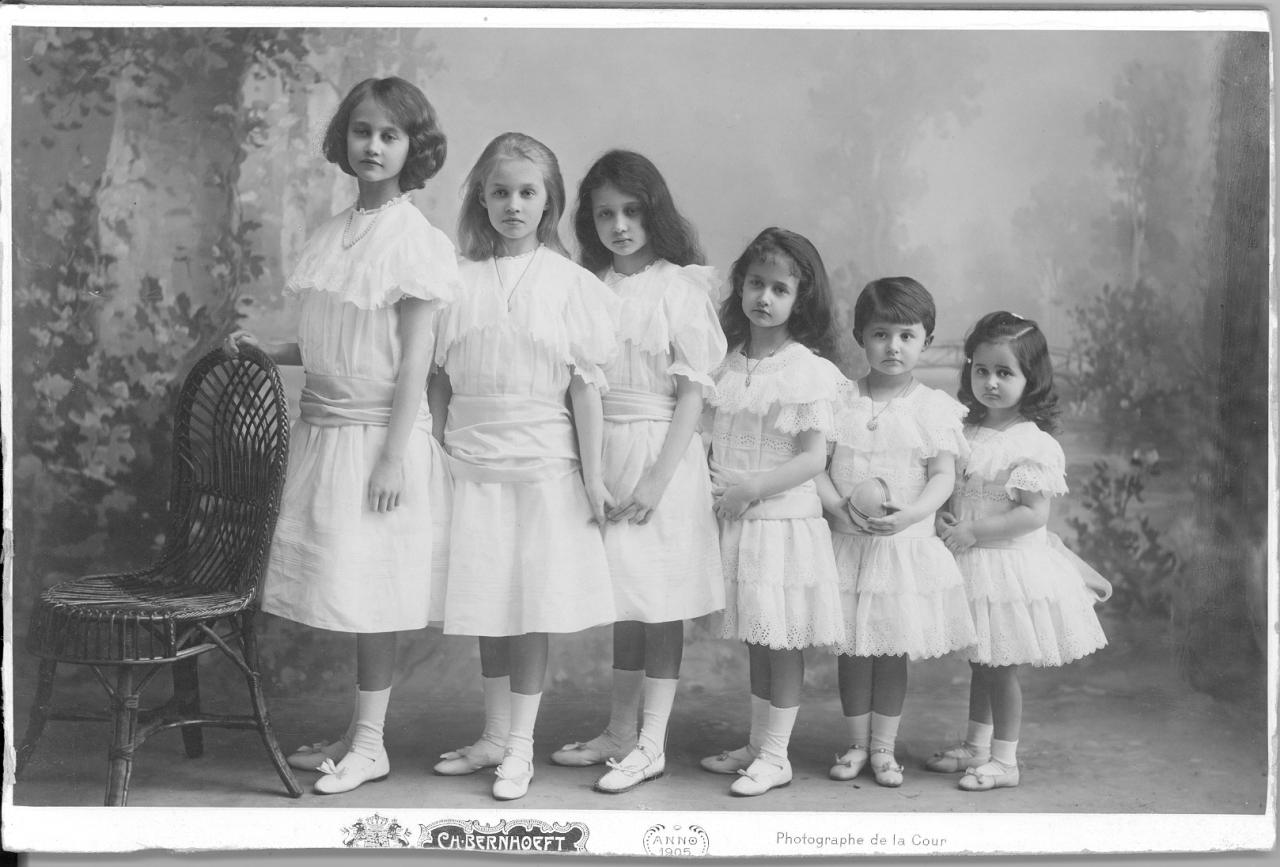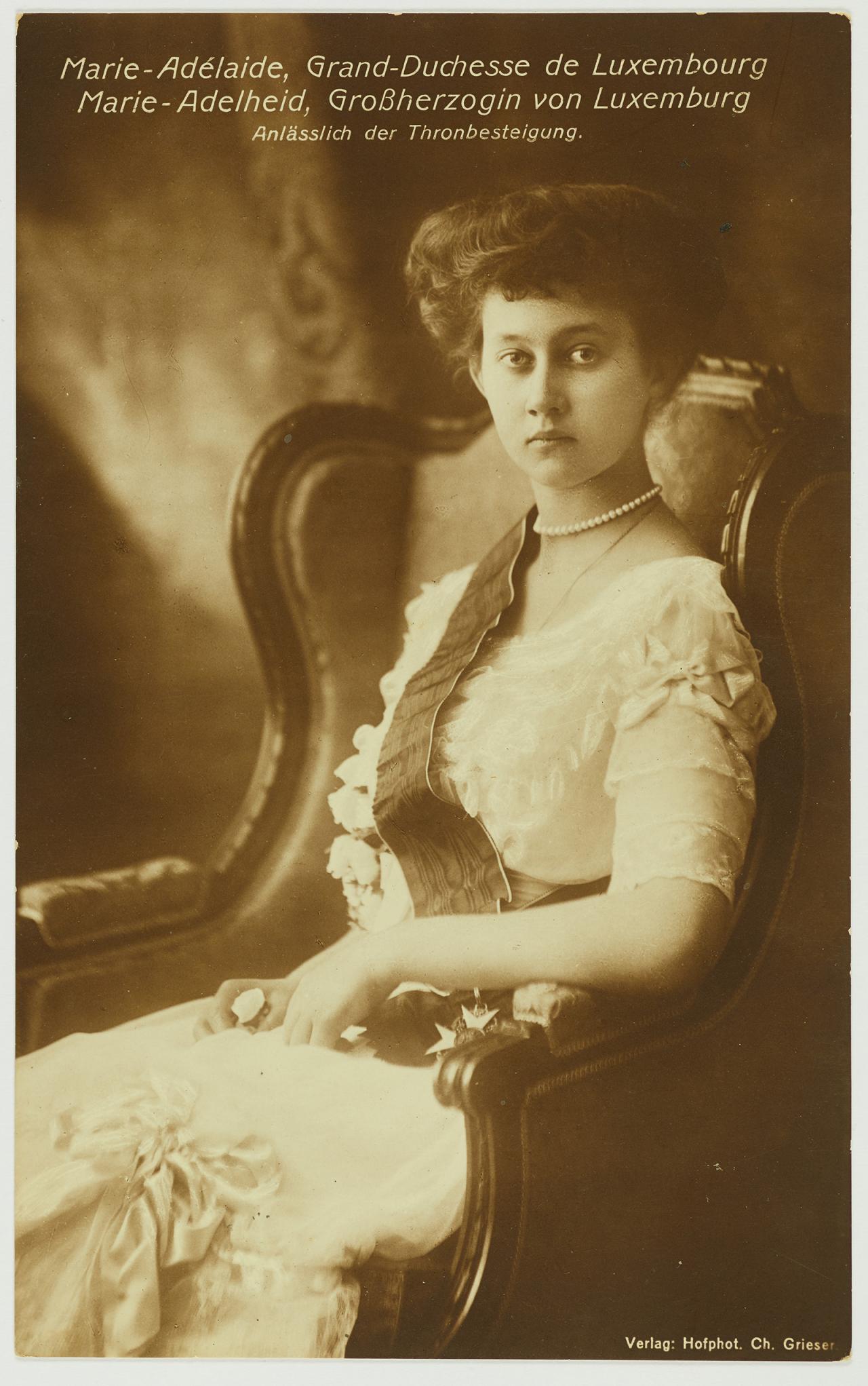
H.R.H. Grand Duchess Marie-Adélaïde
Born on 14 June 1894
at Berg Castle, Luxembourg
Biography
Shaped by political divisions, world war, and the dilemmas of a deeply devout young sovereign, her reign reflects the upheavals of a transformative era.
Marie-Adélaïde was the eldest of six daughters born to Hereditary Grand Duke William and Princess Maria Anna of Braganza, a union that linked the House of Nassau-Weilburg with the former Portuguese royal dynasty. Her birth on 14 June 1894 at Berg Castle was met with great joy and celebrated nationwide. The Grand Duchy rejoiced at the arrival of its first princess born on national soil in centuries - a significant event that inspired hope for a prosperous future.
Son/daughter of
Brothers/Sisters
H.R.H. Grand Duchess Charlotte
H.R.H. Princess Hilda of Luxembourg
H.R.H. Princess Antonia of Luxembourg
H.R.H. Princess Elisabeth of Luxembourg
H.R.H. Princess Sophie of Luxembourg

Princess Marie-Adélaïde and her sisters
© Photographic collections / Cour grand-ducale
Formative Years: Faith and Family

Source : Collection photographique de la Maison grand-ducale
Princess Marie-Adélaïde was baptised at Berg Castle on 16 June 1894. Raised in the devout Catholic faith of her mother, she developed a deep and personal spirituality. This intense and sincere religious conviction became a defining aspect of her character and later influenced her decisions as sovereign. At the same time, she cultivated a passion for the natural sciences and, remarkably, raised three bear cubs until they became too large and were transferred to the Munich Zoo.

Source : Collection photographique de la Maison grand-ducale
At the age of seventeen, she confided to her mother her desire to enter a convent, even suggesting that her younger sister Charlotte assume the responsibilities of succession. This spiritual inclination was likely reinforced by the illness that afflicted her father, Grand Duke William IV, who suffered several strokes and became incapacitated, preventing him from fully performing his duties. Consequently, the Grand Ducal family struggled to maintain a consistent presence in Luxembourg.
From 1906 onward, Marie-Adélaïde and her sisters divided their time between Hohenburg Castle in Bavaria, where their father received medical treatment, Königstein Castle, the home of their paternal grandmother Grand Duchess Adelheid Marie, and Luxembourg, where the princesses began assuming representational duties. In the summer of 1906, Marie-Adélaïde and Charlotte took part in the ‘Flower Festival’ organised by the Luxembourg-Attractions Committee, the precursor to the Luxembourg City Tourist Office. These early experiences helped prepare the future Grand Duchess for public life.
Succession Crisis and Accession to the Throne
In 1907, the Grand Duchy faced a succession crisis. The aphasia and declining health of Grand Duke William IV made the birth of a male heir increasingly unlikely.

© Collections de la Cour grand-ducale
A cousin, the son of a morganatic marriage between Prince Nicholas of Nassau (brother of Adolphe) and the daughter of the Russian poet Alexander Pushkin, laid claim to the throne and family inheritance. This claim found some support among liberal-socialist deputies, including Michel Welter, adding a layer of political complexity to the situation.
Grand Duke William IV resolved the uncertainty by formally confirming Princess Marie-Adélaïde's right to succeed him, amending the 1783 Family Pact. She thus became Hereditary Grand Duchess. Although this decision clarified the line of succession, it did not immediately ease political tensions. Upon the sovereign's death in 1912, and after six months of regency by her mother, Grand Duchess Maria Anna, Marie-Adélaïde - then eighteen years old - ascended the throne. On 18 June 1912, she solemnly took the oath before the government and the Chamber of Deputies, beginning a reign that would prove brief and troubled.

Source : Collection photographique de la Maison grand-ducale

Source : Collection photographique de la Maison grand-ducale

Source : Collection photographique de la Maison grand-ducale
Early Reign: Political Tensions and Religious Influence

Official portrait of H.R.H. Grand Duchess Marie-Adélaïde
© Photographic collections / Cour grand-ducale
Despite a warm welcome at the start of her reign, particularly from the experienced Prime Minister Paul Eyschen, political conflicts quickly emerged in the Chamber of Deputies. The left-wing bloc strongly criticised the Grand Duchess’s apparent reluctance to enact a new education law designed to reduce the clergy’s influence over teacher training. The Catholic Church, by contrast, fiercely opposed the law.
Bishop Jean Joseph Koppes led a vigorous campaign against it, using pastoral letters and sermons to sway public opinion. Under pressure, Marie-Adélaïde initially hesitated to approve the law, citing Article 34 of the Constitution. However, at Eyschen’s insistence, she signed it on 10 August 1912. This episode highlighted the tension between her personal convictions, the demands of a constitutional monarchy, and the political and religious forces at play.
A new crisis erupted in 1915 when Grand Duchess Marie-Adélaïde refused to approve the appointment of mayors deemed anti-clerical in Differdange and Hollerich. She also opposed the appointment of Édouard Oster, her former tutor, as head of the teacher training college. These decisions triggered a ministerial crisis that escalated into a governmental crisis following Paul Eyschen’s death. A new conservative government was formed under the lawyer Hubert Loutsch, composed solely of right-wing ministers - a party that lacked a majority in the Chamber.
To resolve the deadlock, Marie-Adélaïde exercised her constitutional right to dissolve the Chamber and called for new elections. These elections significantly strengthened the right-wing party, whose clerical sympathies aligned with hers. However, the left viewed this move as an attempt to undermine parliamentary democracy and the liberals became increasingly vocal in their anti-monarchist criticism. Ultimately, although the Loutsch government came close to securing a parliamentary majority, it remained in the minority and was swiftly overturned once parliamentary activity resumed.
War and Loss of Support
These internal struggles were further exacerbated by the outbreak of the First World War and the occupation of Luxembourg by German troops in August 1914. The country’s neutrality was violated, and Grand Duchess Marie-Adélaïde’s decision to receive Emperor Wilhelm II - while the German headquarters were established in Luxembourg - sparked fierce criticism.
Although this initiative was primarily orchestrated by Paul Eyschen, it reinforced the perception of a pro-German alignment at court. Whether justified or not, this image significantly damaged the Head of State’s popularity. It is worth noting, however, that both Eyschen and the Grand Duchess sent telegrams of protest to Berlin, denouncing the violation of Luxembourg’s neutrality.
By 1916, Grand Duchess Marie-Adélaïde’s political position had become untenable. A rapid succession of short-lived governments failed to restore public confidence or alleviate food shortages. The Grand Duchess, reluctant to speak publicly, was increasingly perceived as indecisive or absent.
Moreover, the engagement of her sister, Princess Antonia, to Rupprecht, Crown Prince of Bavaria and a prominent figure in the German army, further fuelled suspicions and criticism regarding the Grand Ducal family’s alleged German sympathies.
Abdication and Exile: A Nation in Peril

21 November 1918 – American troops enter the City of Luxembourg
Source : Collection photographique de la Maison grand-ducale
In September 1918, a unity government led by Émile Reuter was hastily formed. After the armistice, its top priority became preserving Luxembourg’s independence, threatened by a possible annexation by Belgium.
However, a decisive meeting with French Foreign Minister Stephen Pichon revealed that the Allies no longer trusted Grand Duchess Marie-Adélaïde to safeguard that independence. The loss of international support, combined with the internal crisis, placed the country in a critical situation.
To prevent the establishment of a republic - or even annexation - the government proposed an unusual but pragmatic solution: the abdication of Grand Duchess Marie-Adélaïde in favour of her sister, Princess Charlotte, whose accession would then be confirmed by referendum.
Aware of the consequences for her country, Marie-Adélaïde agreed to abdicate. She signed the act of abdication on 13 January 1919 and left Luxembourg for Switzerland on 28 January. This marked the beginning of an exile that would last until her death.
Final Years: Faith, Illness, and Legacy
In September 1920, Marie-Adélaïde joined the Carmelite convent in Modena, hoping to take her vows. However, her already fragile health prevented this. She continued her religious vocation with the Little Sisters of the Poor in Rome but contracted paratyphoid fever, which forced her to abandon that pursuit.

HRH Duchess Marie-Anne surrounded by her six adult daughters
Source : Collection photographique de la Maison grand-ducale
Still recovering, she went to Hohenburg, the Bavarian residence of the Grand Ducal family, to receive care. Once seemingly recovered, she enrolled at the University of Munich to study medicine. However, in November 1923, she suffered a relapse, and her health rapidly deteriorated. She died on 24 January 1924, at the age of 29, with her mother by her side. Her body was initially buried in the chapel of Hohenburg Castle; it was not until 1947 that her remains were transferred to the Grand Ducal Crypt of Notre-Dame Cathedral in Luxembourg.
More than a century after her death, Grand Duchess Marie-Adélaïde’s reign remains a subject of debate. Brief but intense, it marked a pivotal period in the evolution of Luxembourg’s constitutional monarchy toward greater modernity. Shaped by political divisions, world war, and the dilemmas of a deeply devout young sovereign, her reign reflects the upheavals of a transformative era.









